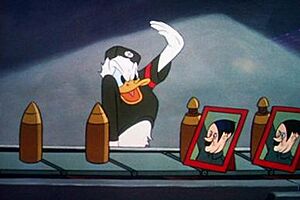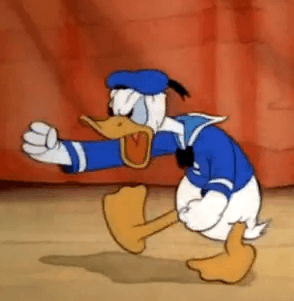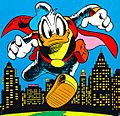Donald Duck facts for kids
Quick facts for kids Donald Duck |
|
|---|---|
| First appearance | The Wise Little Hen (1934) |
| Created by | Walt Disney |
| Voiced by | Clarence Nash (1934–1985) Tony Anselmo (1985–) |
| Developed by | Dick Lundy, Fred Spencer, Carl Barks, Jack Hannah |
| Information | |
| Full name | Donald Fauntleroy Duck |
| Nickname(s) | Don |
| Aliases | Frank Duck Fred Duck Avenger (USA) Superduck (UK) Italian: Paperinik Norwegian: Fantonald |
| Species | Pekin duck |
| Family | Duck family |
| Significant other(s) | Daisy Duck |
| Relatives | Scrooge McDuck (uncle) Ludwig Von Drake (granduncle) Huey, Dewey, and Louie (nephews) Clan McDuck (maternal relatives) |
Donald Duck is a famous cartoon character created by Walt Disney. He is a white duck with an orange bill and legs. Donald usually wears a sailor cap, a sailor shirt, and a red bow tie.
He first appeared on screen in the cartoon The Wise Little Hen on June 9, 1934. Donald is Scrooge McDuck's nephew. His girlfriend is Daisy Duck, and his nephews are Huey, Dewey, and Louie. Donald has starred in many animated shorts, comic books, and newspaper comic strips. You can often see him in The Mickey Mouse Clubhouse. Donald Duck is one of the most popular cartoon characters ever! He is also very well known for his adventures in comics around the world.
Contents
Donald Duck's Personality
Donald Duck is known for being a bit impatient and sometimes immature. He can also be a little bit arrogant and pessimistic. However, he also has a very upbeat attitude towards life!
Many of Donald's cartoons start with him feeling happy and carefree. But then, something usually happens to spoil his day. His famous temper often causes him trouble. It can make him get into difficult situations and even lose competitions. Sometimes, he tries hard to control his anger. He might succeed for a little while, but he always goes back to his usual angry self.
Even though his temper can be a problem, Donald's strong nature can also help him. It has helped him get through tough times when he needed to be brave.
Donald also loves to play pranks. Because of this, he can sometimes seem like a bully. But most of the time, Donald's pranks are harmless. He almost never means to hurt anyone. If his pranks go too far, he often feels sorry for what he did.
Donald also likes to show off. He loves to brag about how good he is at things. He actually has many skills and is good at lots of different activities. He is a talented fisher, a good hockey player, and a skilled pianist. However, his bragging often makes him think he's better than he is. When he tries to prove his boasts, he usually gets into funny trouble.
Another important part of Donald's personality is his perseverance. Even though he can be a bit lazy sometimes and loves to relax in a hammock, once he decides to do something, he gives it his all. He will sometimes go to extreme lengths to reach his goals!
How Donald Duck Was Created
The voice actor Clarence Nash was looking for work at Walt Disney Studios. Disney was looking for people who could make animal sounds for his cartoons. Walt Disney was very impressed with Nash's duck sound. He chose Nash to be the voice of a new character.
Walt Disney came up with Donald's famous traits. These include his short temper and his sailor suit. The sailor suit was chosen because both ducks and sailors are connected to water. While Dick Huemer and Art Babbit first drew Donald, Dick Lundy is known for developing his personality.
On April 29, 1934, just before The Wise Little Hen was released, people heard Donald's voice for the first time. Clarence Nash performed Donald Duck's voice on a radio show called California Melodies.
Donald Duck in Cartoons
Early Cartoons
Donald Duck first appeared in the 1934 cartoon The Wise Little Hen. This cartoon was part of the Silly Symphonies series. The Walt Disney Company officially celebrates June 9 as Donald's birthday. However, historians have found that the cartoon was first shown on May 3, 1934.
In this first cartoon, Donald looked similar to his modern self. His feathers and beak were the same colors, and he wore a blue sailor shirt and hat. But his body was plumper, his features were longer, and his feet were smaller. His personality wasn't fully developed yet. He just played an unhelpful friend.
Donald then appeared in a Mickey Mouse cartoon called Orphans' Benefit in 1934. Donald tried to recite poems for Mickey's orphans. But the mischievous orphans kept bothering him. This made Donald fly into a loud, angry fit. This explosive personality became a key part of Donald for many years.
Audiences loved Donald. He started appearing regularly in most Mickey Mouse cartoons. Cartoons from this time, like The Band Concert (1935), are considered classics. In this film, Donald constantly interrupts Mickey Mouse's orchestra by playing a different tune.
In 1936, Donald's look was updated. He became a bit fuller, rounder, and cuter. This new look started with the cartoon Moving Day. He also began starring in his own cartoons. The first solo cartoon was Don Donald in 1937. This short also introduced Donna Duck, who later became Daisy Duck. Donald's nephews, Huey, Dewey, and Louie, first appeared in animation in 1938 in Donald's Nephews. By 1938, many polls showed that Donald was even more popular than Mickey Mouse!
Donald During Wartime

During World War II, Donald appeared in several propaganda films. These films were made to support the war effort. One famous example is Der Fuehrer's Face from 1943. In this cartoon, Donald works in a factory in "Nutzi Land" (which represents Nazi Germany). He struggles with long hours and tiny food portions. He also has to salute every time he sees a picture of the Führer (Adolf Hitler).
Donald eventually has a nervous breakdown from the stress. Then he wakes up and realizes it was all a dream. At the end of the cartoon, Donald looks at the Statue of Liberty and the American flag with great appreciation. Der Fuehrer's Face won an Academy Award for Animated Short Film in 1942.
Donald also starred in a series of six short films about his time in the U.S. Army. These films showed him getting drafted, going through basic training, and even going on a mission as a commando. In Donald Gets Drafted (1942), we learn Donald's full name: Donald Fauntleroy Duck. Other films in this series include:
- The Vanishing Private (1942)
- Sky Trooper (1942)
- Fall Out Fall In (1943)
- The Old Army Game (1943)
- Commando Duck (1944)
Because of these films, Donald's image was often painted on the noses of Allied airplanes during World War II. He became a mascot for many military groups. Donald also appeared as a mascot for the U.S. Coast Guard Auxiliary. He was shown as a fierce pirate ready to protect the American coast.
One of Donald's most famous appearances was on a B-25B Mitchell bomber called "The Ruptured Duck." This plane was part of the Doolittle Raid on Tokyo in 1942. The plane had a picture of Donald's face above crossed crutches.
During World War II, Disney cartoons could not be sent to Occupied Europe. To make up for lost money, Disney decided to find new audiences in South America. Walt Disney traveled through Latin American countries with his team. Their experiences inspired two animated movies. The first was Saludos Amigos (1942), which had four short parts. Donald Duck appeared in two of them, where he met his parrot friend José Carioca. The second film was The Three Caballeros (1944), where Donald met his rooster friend Panchito.
Many years after the war, Donald Duck was officially retired from active duty in the U.S. Army. This happened during his 50th Birthday celebrations in 1984. He was retired as a "Buck Sergeant."
After the War
After the war, many of Donald's films showed him being bothered by other characters. His nephews, the chipmunks Chip 'n' Dale, or other animals would often annoy him. Donald was often the one being attacked or teased. This was a change from earlier cartoons where he was often the one causing trouble.
Donald also starred in educational films, like Donald in Mathmagic Land (1959). He also made guest appearances in other Disney projects. His uncle Ludwig von Drake was created for the Disneyland TV show in 1961. His rich uncle, Scrooge McDuck, first appeared in animation on the show in 1967. Scrooge had been a popular character in comics for decades before this.
In the movie Who Framed Roger Rabbit (1988), Donald had a funny piano duel with Warner Brothers character Daffy Duck. Donald has appeared in many TV shows and short animated movies since then. He had roles in The Prince and the Pauper (1990) and a small part in A Goofy Movie (1995).
Donald had a smaller role in the TV series DuckTales (1987). In this show, Donald joined the U.S. Navy. He left his nephews Huey, Dewey, and Louie with their Uncle Scrooge. Donald only appeared in a few episodes when he was home on leave.
Donald also starred in his own TV show called Quack Pack. This series showed a more modern Duck family. Donald no longer wore his sailor suit. Instead, he wore a Hawaiian shirt. Huey, Dewey, and Louie were teenagers with different clothes and personalities.
He made a big comeback as the star of the "Noah's Ark" part of Fantasia 2000 (1999). Donald was Noah's first mate. He helped gather the animals onto the Ark. He thought Daisy was lost, and she thought the same about him. But they were reunited at the end.
Donald also played an important role in Mickey Mouse Works and House of Mouse. In House of Mouse, he was the co-owner of Mickey's nightclub. He is also a main character in Mickey Mouse Clubhouse. He appears in the new 3-minute Mickey Mouse TV shorts for Disney Channel.
Donald is a main character in the DuckTales reboot (2017). In this show, he used to be Scrooge's adventure partner with his sister Della. But Della went missing, and Donald and Scrooge stopped talking for ten years. Donald reluctantly brings his nephews to Scrooge's mansion so Scrooge can babysit them. Donald's anger in this series is shown to come from a fear that no one understands him. With help, he learns to use his anger to protect his nephews.
Voice Actors
Donald's first voice was done by Clarence Nash. He voiced Donald for 50 years! No one else was allowed to do Donald's voice while Nash was alive. Nash voiced Donald for the last time in Mickey's Christmas Carol (1983). He continued to do Donald's voice for commercials until he passed away in 1985.
Since Nash died, Donald's voice has been performed by Disney animator, Tony Anselmo. Nash actually taught Anselmo how to do the voice. Anselmo's first performance as Donald was in a 1986 TV special. His first feature film was Who Framed Roger Rabbit in 1988.
Walt Disney believed in keeping characters consistent. In 1988, Roy E. Disney created a department to make sure Disney characters always sounded the same. Tony Anselmo was approved as the official voice of Donald Duck.
For the TV series Mickey and the Roadster Racers, Donald was voiced by Daniel Ross. However, Anselmo continues to be the official voice of Donald Duck for most Disney projects.
In the 2017 DuckTales reboot, a young Donald was voiced by Russi Taylor. After her death, Cristina Vee took over the role. An alternate voice for Donald was provided by Don Cheadle in some episodes.
Donald Duck Around the World
Nordic Countries
Donald Duck is very popular in Nordic countries. He is known as Kalle Anka in Sweden, Anders And in Denmark, Andrés Önd in Iceland, Donald Duck in Norway, and Aku Ankka in Finland.
An annual Christmas TV special called From All of Us to All of You is a big tradition in these countries. Many people watch this special every Christmas Eve. It's as important as having a Christmas tree for them!
Germany
Donald Duck comics sell about 250,000 copies every week in Germany. Donald's words in German comics are often more complex and thoughtful. He might quote German literature and use complicated sentences. The stories can also have a more political tone than American comics. The artists who draw Donald, like Carl Barks and Don Rosa, are very well known in Germany. They even have their own fan clubs!
Italy
In Italy, new stories about Donald Duck (named Paolino Paperino) and Scrooge McDuck appear in the weekly comic Topolino. Donald is almost always called Paperino by everyone in Italy, even his nephews.
There are also comics about Donald's childhood called Paperino Paperotto (which means "Donald Duckling"). These comics started in Italy in 1998. In these stories, he lives in a town called Quack Town with Grandma Duck.
Donald Duck at Disney Theme Parks

Donald Duck has been a big part of many Disney theme parks. He has appeared in more attractions and shows than even Mickey Mouse! You can see him in rides like Animagique, Mickey's PhilharMagic, and Gran Fiesta Tour Starring the Three Caballeros. He also appears as a character you can meet and take pictures with at the parks.
Donald Duck in Books
Donald has been a character in children's books since 1935. Many of these books were published by Whitman Publishing. Here are some of the books where Donald is the main character:
- Walt Disney's Donald Duck (1935)
- Donald Duck Story Book (1937)
- Donald Duck Has His Ups and Downs (1937)
- Donald's Lucky Day (1939)
- Donald Duck and His Cat Troubles (1948)
- Bringing up the Boys (1948)
- Donald Duck's Kite (1949)
- Donald Duck and the Wishing Star (1952)
- Donald Duck Goes to Disneyland (1955)
- Help Wanted (1955)
- Donald Duck and the Lost Mesa Ranch (1966)
- Donald Duck: Board Book (1969)
- Better Little Books
- Donald Duck Gets Fed Up (1940)
- Donald Duck Sees Stars (1941)
- Off the Beam (1943)
- Headed for Trouble (1943)
- Donald Duck and Ghost Morgan's Treasure (1946)
- Donald Duck and the Green Serpent (1947)
- Donald Duck Lays Down the Law (1948)
- Donald Duck in Volcano Valley (1949)
- The Great Kite Maker (1949)
- Donald's Toy Train (1950)
- Donald Duck's Adventure (1950)
- Donald Duck and Santa Claus (1952)
- Donald Duck and the Witch (1953)
- Donald Duck's Toy Sailboat (1954)
- Donald Duck's Christmas Tree (1954, 1991)
- Donald Duck's Safety Book (1954)
- Donald Duck in Disneyland (1955)
- Donald Duck and the Mouseketeers (1956)
- Donald Duck and the Christmas Carol (1960)
- Donald Duck and the Witch Next Door (1971)
- Disneyland Parade with Donald Duck (1971)
- Donald Duck: Private Eye (1972)
- Donald Duck: Prize Driver (1974)
- America On Parade (1975)
- Donald Duck and the One Bear (1978)
- Instant Millionaire (1978)
- Where's Grandma? (1983)
- Donald Duck and the Big Dog (1986)
- Some Ducks Have All the Luck (1987)
- Tell-a-Tale Books
- Donald Duck's Lucky Day (1951)
- Full Speed Ahead (1953)
- Donald Duck and the New Birdhouse (1956)
- Donald Duck in Frontierland (1957)
- Donald Duck and the Super-Sticky Secret (1985)
- Tom Sawyer's Island (1985)
- Little Big Books
- The Fabulous Diamond Fountain (1967)
- Luck of the Ducks (1969)
- Donald Duck in Volcano Valley (1973)
- The Lost Jungle City (1975)
- Other Publishers
- Donald Duck (1936) by Grosset and Dunlap
- Donald Duck and His Friends (1939) by D.C. Heath and Co.
- Donald Duck and His Nephews (1939) by D.C. Heath and Co.
- Donald Duck and the Magic Stick (1974) by Random House
- Donald Duck: Mountain Climber (1978) by Random House
- Donald Duck's Big Surprise (1982) by Random House
- Donald Duck Buys a House (1982) by Random House
- The Donald Duck Book (1978) by Walt Disney Productions
- Baby Donald's Day at the Beach (2001) by Grolier/Scholastic
- Baby Donald Makes a Snowfriend (2005) by Grolier/Scholastic
Donald Duck's Other Appearances

- Donald is the only cartoon character to be a mascot for a major American university. The University of Oregon uses Donald's image as their "Fighting Duck" mascot. In 1984, Donald Duck was even made an honorary alumnus of the university!
- Donald was one of the few famous people mentioned in the original song "Hooray for Hollywood" from 1937.
- In the 1940s, Donald became the mascot for a Brazilian sports club called Botafogo.
- Donald's name and image are used on many products, like Donald Duck brand orange juice, which started in 1940.
- Donald Duck's head and neck were painted on the nose of a B-25 Mitchell bomber called "The Ruptured Duck." This plane was part of the famous Doolittle Raid on Tokyo in 1942.
- In 2005, Donald received his own star on the Hollywood Walk of Fame. He joined other famous characters like Mickey Mouse and Bugs Bunny.
- Donald has been in many video games, including the Kingdom Hearts series. In these games, Donald is the court magician of Disney Castle. He travels with Goofy and a boy named Sora to find King Mickey Mouse and fight evil.
- Asteroid 12410 was named after Donald Duck.
Images for kids
See also
 In Spanish: Pato Donald para niños
In Spanish: Pato Donald para niños





